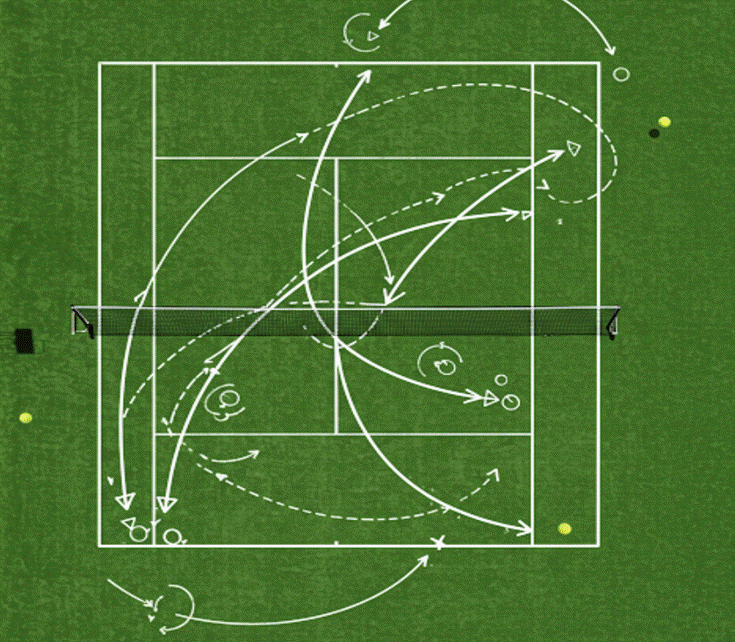
Figure 1: Game plan for a dynamic tennis doubles match (generated with Gemini).
Introduction
In this article, I draw parallels between the rules and dynamics of tennis and the soft skills essential for UX research. Tennis is a game of precision, strategy, and collaboration—a sport in which success depends as much on mental agility and teamwork as on physical skill. Just as tennis players rely on clear communication, adaptability, trust, and resilience to navigate each match, UX researchers must develop these same traits to thrive in their roles. By exploring these connections, I’ll show how the lessons learned on the court can serve as a powerful framework for building and refining the soft skills that drive impactful UX Research (UXR).
The midday sun beat down on the court, the chalk lines glaring white. At the tennis court, my partner and I faced a tricky pair. They were consistent and steady, but they lacked that spark, that coordinated dance that separates good teams from great teams. Our teammates watched from the sidelines, offering quiet encouragement and noting the subtle shifts in momentum.
Watching the opposing team struggle with communication and coordination on the tennis court, I realized how vital these same skills are in UX research. Each cross-functional partner—designer, product manager, engineer—brings a unique playing style, just like teammates in a doubles match. Cross-Functional (XFN) partners are individuals from different disciplines, like UX researchers, product managers, designers, and engineers, who collaborate closely to achieve shared goals in product development.
Success relies on building strong partnerships and adapting my communication and approach to meet each partner’s needs to ensure we deliver products that truly champion the user. Like on the court, collaborating with XFN partners in UXR demands strategy, flexibility, and clear communication about research findings, which serves as the ball that keeps our game in motion.
Pre-Match Presence: Laying the Groundwork for Trust
For me, a doubles match journey starts well before I step onto the court; it begins days earlier during practice sessions with my partner. Arriving early, running drills, and rehearsing plays help us learn each other’s strengths, build clear communication, and develop trust. By the time match day arrives, we operate as a true team.
I take the same approach in UX research. Before any official session, I invest time in preparation: reviewing objectives, running mock interviews, and practicing with my XFN partners. These efforts help us align, anticipate challenges, and build the confidence to collaborate effectively. When it’s time for the real match, I show up fully prepared and in sync with my team, ready to deliver the best.
How can you prepare XFN partners for a gameful match of UXR?
Your Next Move
- Schedule practice sessions: Hold mock interviews or dry runs with your team before the research starts to build trust and alignment.
- Show up prepared: Arrive early and ready, demonstrating reliability from the start.
- Build rapport: Use practice days to learn your teammates’ styles and strengthen communication.
- Stay engaged: Be attentive and actively contribute in every practice and live session.
- Anticipate challenges: Use practices to spot gaps and refine your approach.
- Always have a backup: Prepare contingency plans—just like bringing a spare racket—to handle any surprises.
Game Plan: Communication and Transparency
On the tennis court, if I miss a call or hesitate to say, “let it go,” my team can lose points. The same is true in UX research: Clear, precise communication is essential for success. I make sure that goals and expectations are aligned so my team moves in the same direction.
Just like calling the play-by-play in a match, I provide regular, digestible updates on research progress and actively seek feedback. This transparency builds trust and keeps everyone aligned. But clear communication isn’t just about speaking; it’s about listening with empathy.
By understanding your team’s concerns and priorities, you can communicate in a way that resonates and strengthens your connection.
Your Next Move
- Call the shots early: Set up clear communication channels at the start of a project to avoid confusion later.
- Keep everyone in the loop: Share regular, bite-sized updates that are easy for your team to follow.
- Listen with empathy: Go beyond hearing words to understanding the emotions, motivations, and concerns behind them.
- Double-check the play: Confirm decisions and next steps to avoid misunderstandings.
Knowing Your Position on the Court: Strategic Alignment
In doubles, knowing my position on the court is vital. I need to understand my partner’s strengths, anticipate their next move, and adapt to cover the court effectively. In UX research, strategic alignment means understanding the roles of my team members and aligning my research with our overarching business objectives.
Empathy plays a big role. I must put myself in the shoes of my teammates and my stakeholders. By understanding their perspectives, I align my work with their priorities and anticipate their needs.
Ensure your insights, delivered through empathy, fit into the bigger picture.
Your Next Move
- Know your role: Take time to learn what each team member does and how their strengths can complement yours.
- Cover the gaps: Identify potential blind spots in the team’s workflow and fill them proactively.
- Aim for shared goals: Use empathy to understand your team’s priorities and tie your research insights to business objectives.
Moving with the Rally: Adaptability and Responsiveness
Tennis matches are all about constant adjustments. We need to read our opponent, anticipate their next move, and adapt our strategy. Similarly, UX research requires flexibility. This means tailoring research approaches to meet evolving needs, reprioritizing based on market dynamics, and pivoting methodologies when outcomes deviate from expectations.
Empathy is the key to staying adaptable. By understanding the challenges my team members face and the pressures they’re under, I can respond with solutions that are both effective and considerate.
Being flexible doesn’t just mean changing plans. It means adjusting to what’s best for the team.
Your Next Move
- Stay on your toes: Anticipate your team’s needs and adjust your plans as priorities shift.
- Move with agility: Be ready to adapt methodologies or communication styles to address unforeseen changes.
- Refine the game plan: After every research step, or rally, evaluate what worked and what didn’t, then adjust accordingly.
Backing up Your Partner: Support and Advocacy
On the tennis court, I’ve got my partner’s back by covering the baseline when they’re struggling at the net or offering encouragement when the game gets tough. In UX research, success comes from creating a supportive, collaborative dynamic.
As a researcher, my role goes beyond delivering insights. I advocate for users, champion user-centered design, and ensure my team feels supported in achieving shared goals. Empathy is at the heart of this support. Empathy allows me to understand both the needs of the users and the challenges my team members face, so I can offer meaningful solutions and encouragement.
Your Next Move
- Be their safety net: Use empathy to understand when your team needs support and step in to provide it.
- Cheer for the user: Always keep the user’s voice front and center in discussions and decisions.
- Celebrate the wins: Don’t forget to acknowledge team successes, no matter how small. Success builds momentum.
Controlled Placement: Teaming with Strong Opinion
Some partners, though equally skilled, may assert their expertise or try to take control of the process, or the rally. Navigating these dynamics calls for the same finesse as placing a precise shot during a heated doubles match. Instead of meeting power with power, I rely on controlled placement. Build common ground, use data to set the aim, and adapt communication styles to keep the team’s rhythm smooth.
Empathy, like my grip on the racket, allows me to read my partner’s moves and understand the force behind their opinions. By tuning into their concerns, I can shape my persuasion to frame insights in ways that feel like a well-placed return rather than a direct challenge. In this way, empathy and strategic persuasion help me turn potential clashes into seamless collaborations, transforming strong opinions into our team’s advantage.
Your Next Move
- Find common ground: Use empathy to uncover shared objectives and build on them.
- Back it up: Reinforce your arguments with data and user insights to build credibility.
- Frame the conversation: Recast insights to align with your partner’s perspective while staying true to user needs.
- Ask smart questions: Use strategic, empathetic questions to guide discussions and uncover more profound insights.
- Respect expertise: Recognize and value your partner’s strengths to foster collaboration.
Coordinated Movement: The Rally Rope of Collaboration
We are more than just researchers. We are teammates. Moving toward a shared research goal requires everyone to have clarity, support during tough moments, and teammates who can rally together as if everyone on the team were holding a rally rope. Just like in doubles tennis, success comes from trust, coordination, and knowing your team has your back.
Your Next Move
- Visualize the connection: Imagine your team as linked by an invisible rally rope to stay aligned.
- Move in sync: Use empathy to anticipate your team’s shifts and adjust your approach to stay coordinated.
- Pull together: Work as a unit to leverage everyone’s strengths and drive toward the shared goal.
- Stay flexible: Allow the connection, or rope, to stretch and recover when priorities shift or challenges arise.
Key Takeaways
To wrap up, here are the core principles of using soft skills to champion UXR teams:
- Prepare like a pro: Show up early, align with your team, and always have a backup plan, just as you would before a big match. Preparation builds trust and sets your team up for success.
- Build strong partnerships: Success depends on relationships. Foster empathy and collaboration with your teammates (designers, project managers, and engineers) for smoother, more effective teamwork.
- Communicate with clarity and empathy: Keep your team informed and engaged through regular, transparent updates. Listen actively and tailor your communication style to your audience.
- Stay flexible and adaptive: Be ready to adjust your approach as priorities and challenges shift. Adaptability, on the court and in UX research, leads to better results.
- Support your team and advocate for users: Be a source of encouragement and backup for your team. Keep the user’s needs at the center of every decision and discussion.
- Celebrate wins and learn from every game: Acknowledge even small successes and reflect on setbacks. Continuous learning and positive reinforcement drive team growth.
Grab your racket, rally your team, and ace the game of UX research together!
Naghmeh Nouri Esfahani, PhD, MBA, is a senior UX researcher with a strong foundation in Industrial Design. At Cisco, she leads mixed-method research initiatives for Webex Contact Center, driving the product’s strategic vision and direction. With over 12 years of experience, Naghmeh excels at delivering actionable insights that enable cross-functional teams to craft impactful user experiences for both consumer and enterprise solutions.


User Experience Magazine › Forums › Game, Set, Match: Soft Skills for UX Research Champions